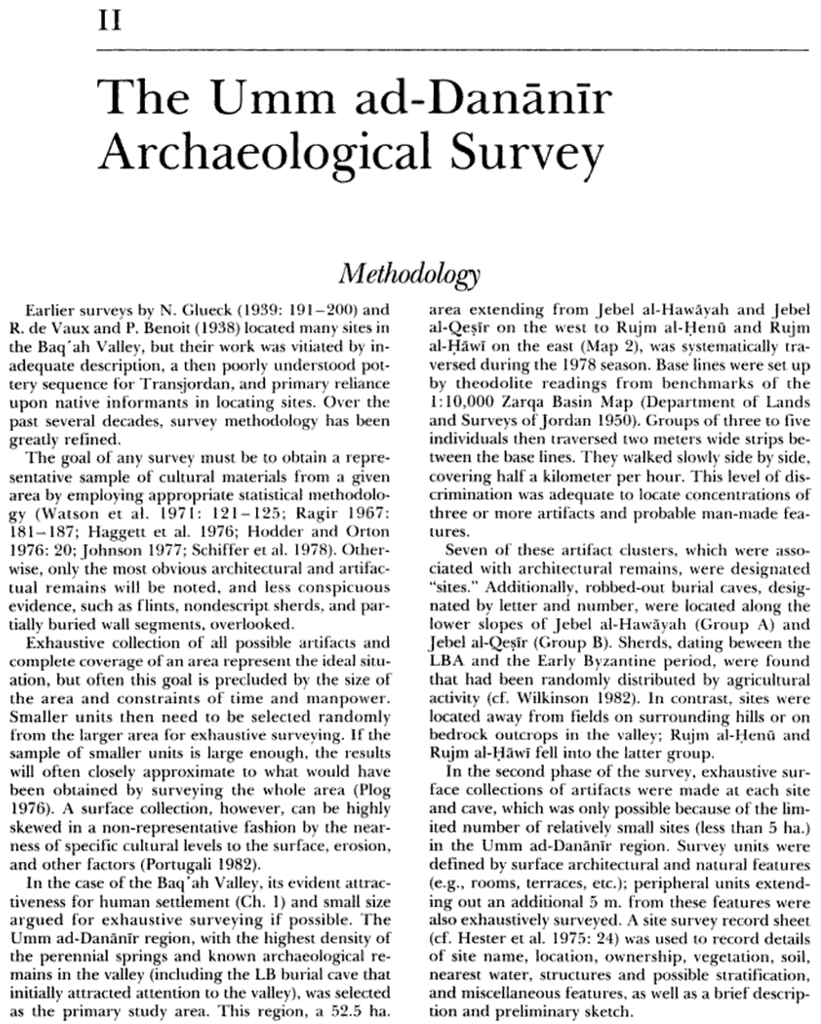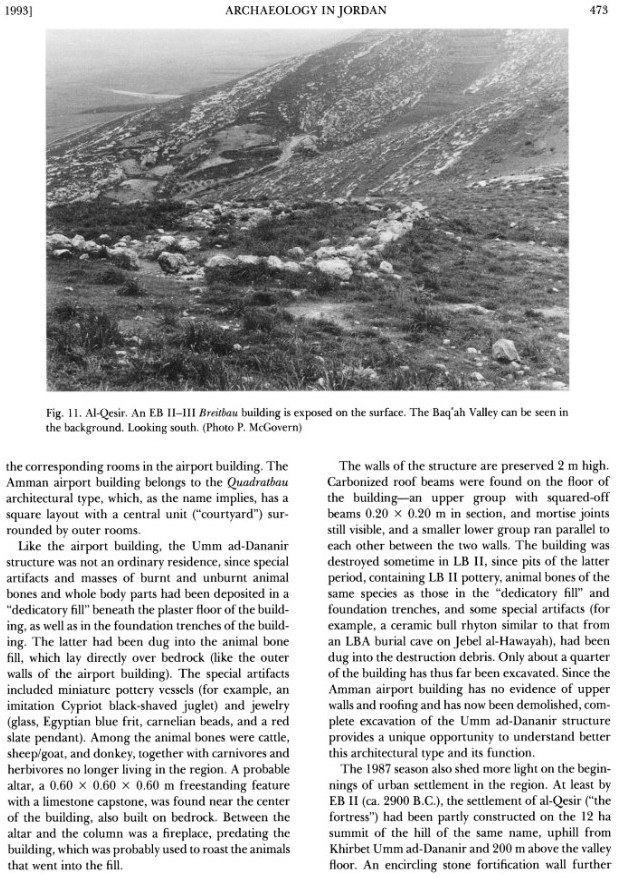|
Other Archaeological Sites / The Neolithic of the Levant (500 Page Book Online) The Late Bronze and Iron I Umm ad-Danānīr Proofread and Updated April 17th 2019
The History and Archaeology of Jordan: The Second Millennium BC by Patrick McGovern
University of Pennsylvania Museum of Archaeology and Anthropology Monograph 65
The Late Bronze Age and Early Iron Ages of Central Transjordan: The Baq‘ah Valley Project, under the directorship of Patrick McGovern, was initiated in 1977 and continued for four seasons. The main focus has been the elucidation of the Late Bronze (LB) and early Iron periods. Nelson Glueck in his pioneering survey of the central and southern Transjordanian plateau (1934, 1935 and 1939) had noted a relative absence of LB remains which led him to hypothesize that the region had been inhabited largely by nomads and ‘semi-nomads’ before the emergence of national states (Ammon -- Moab -- Israel). Yet the appearance of exceptionally well-made LB I (circa 550-1400 B.C.) pottery on the Amman antiquities market in 1975-76, which was traced back to a robbed cave in the Baq‘ah, pointed to a well established sedentary community. The initial goal was a trial sounding with the hope of finding and excavating an undisturbed stratigraphic sequence of Late Bronze Age pottery and artifacts. The results were so impressive that the sounding was followed up in 1978 by an intensive archaeological and geophysical survey of the Umm ad-Danānīr region where a 52.5 hectare area was systematically traversed in 1978 ... The survey itself produced evidence of almost all archaeological periods from the Middle Paleolithic to the present. Chapter II: The Umm ad-Danānīr Archaeological Survey Methodology --- Earlier surveys by Nelson Glueck (1939: 191-200) and R. de Vaux and P. Benoit (1938) located many sites in the Baq‘ah Valley but their work was vitiated by inadequate description, a then poorly understood pottery sequence for Transjordan and primary reliance upon native informants in locating sites. Over the past several decades survey methodology has been greatly refined. In the case of the Baq‘ah Valley its evident attractiveness for human settlement and small size argued for exhaustive surveying if possible. The Umm ad-Danānīr region, with the highest density of perennial springs and known archaeological remains in the valley (including the LB burial cave that initially attracted attention to the valley), was selected as the primary study area. Sherds dating beween the LBA and the Early Byzantine period were found that had been randomly distributed by agricultural activity (Wilkinson 1982). In contrast sites were located away from fields on surrounding hills or on bedrock outcrops in the valley.
Results: Immediate access to valuable natural resources and strategic location would appear to have been the main determinants of human settlement in the Baq'ah. This conclusion was borne out by the Umm ad-Danānīr survey which produced archaeological evidence dating to virtually every period from the late Middle Palaeolithic (circa 45,000 B.P.) to the present (McGovern 1980). Major periods as yet unattested include Early Bronze I, Abbasid and Fatimid (Table 1). No Hellenistic evidence was found on the surface but remains of this period have been excavated at Khirbet Umm ad-Danānīr. Pre-Bronze Age remains were limited to clusters of lithics of Middle Palaeolithic -- Epipalaeolithic and Neolithic date on the lower slopes of Jebel al-Hawayah and Jebel al-Qesir. These groups may represent encampments (possibly along an ancient lake shore) or, more likely, wash-out from nearby caves (Rollefson 1985). Two archaeological periods, the Early Bronze Age and the Iron IIC/Persian period, one preceding and the other following the main periods of interest, the LBA and early Iron Age, were especially well attested and served to place the latter periods in perspective. Urban settlement began in the region at least by Early Bronze II (circa 2900 B.C.). The impressive site of al-Qesir or “the fortress” has outlines of many stone buildings visible on the surface and covers the 5 hectare summit of the hill of the same name at an elevation of about 800 metres ASL. An encircling stone fortification wall further enhanced its defensive position which must have been all-important considering the 200 metre change in elevation from the valley floor to the top of the hill. Cisterns up to several hundred meters in diameter, which probably supplied most of the water, were hewn out of the bedrock on four sides of the summit. The perennial springs on the north and south ends of the hill would have been important back-up water sources especially in times of drought but they could only be reached by difficult climbs. Numerous Iron IIC/Persian structures, dating between circa 650 and 400 B.C., are scattered throughout the Baq’ah (Glueck 1939: 191-200; de Vaux and Benoit 1938: 417-422). Some of these are isolated buildings but others form extensive complexes such as Khirbet Mudmar near the center of the valley which is comprised of four massive structures. The buildings in all cases are constructed of irregularly shaped dry-laid boulders each weighing up to a ton. Some walls still stand to a height of 5 metres.
The main features of these buildings are large rectangular or square enclosures and circular towers which are either incorporated into walls or separated by short distances from the main structures; completely isolated towers also occur (see Glueck 1937: 159). Functionally these buildings have usually been interpreted as watchtowers or fortresses which protected approaches to Amman. An alternative hypothesis is that such buildings served as habitation quarters for the rural Ammonite population (Glueck 1939: 163). The Umm ad-Danānīr survey results support an expanded form of the latter hypothesis, namely that the spatial distribution of Iron IIC/Persian sites implies a settlement pattern that maximally exploited available agricultural land (McGovern 1983). Five Iron IIC/Persian sites were located in the Umm ad-Danānīr region. Apart from Khirbet Umm ad-Danānīr all were constructed on bedrock outcrops near arable land. One building (Rujm al- Hawayah) was in a fertile side wadi and thus could hardly have served a border post function. This site and Rujm Ain Umm ad-Danānīr were most likely population offshoots of Khirbet Umm ad-Danānīr in prosperous times. The latter was the main stratified site of the region, dating back to LB IA. Khirbet Umm ad-Danānīr (Site 3/Field 5) By at least the beginning of the LBA (circa 1550 B.C.) settlement had moved downhill from the summit along the northwestern flank of Jebel al-Qesir closer to the strongest spring in the region, Ain Umm ad-Danānīr. The site of Khirbet Umm ad-Danānīr, one of the larger stratified sites (circa 2.5 hectares) in the Amman area, is situated on a series of at least five terraces with a total change in elevation of approximately 50 metres. Potential defensibility again must have been a critical factor in selecting the location. A 30 metre sheer cliff separates the lowest terrace from the wadi below. In addition a probable outer town wall, which was composed of two lines of roughly shaped boulders with an overall width of 1.5-2 metres, could be traced on the surface (Figure 1) ... The site would have been ideally situated to monitor movement through the southern branch of the Wadi Umm ad-Dandanir since there is an extensive view down the wadi with the Jordan Valley and the Ajlun in the distance as well as a full view of the Baq‘ah. The site had been previously explored by Glueck (1939: 197-198) and de Vaux and Benoit (1938: 421) who noted the ancient wall structures intermingled with modern terrace walls. Sherds were collected which dated to the Early Iron I-II -- Roman -- Byzantine and Islamic periods. The exhaustive surface survey of 1978 demonstrated the importance of LB II (circa 1400-1200 B.C.) occupation at the site. A single MB II (circa 1750-1650 B.C.) sherd suggested earlier human activity. As a result of refinements in the pottery chronology of Transjordan the Iron Age material from Khirbet Umm ad-Danānīr can be assigned to more precise categories than those used by Glueck and de Vaux: Iron IA (circa 1200-1050 B.C.) -- IC (circa 1000-900 B.C) -- IIA-B (circa 900-750 B.C.) -- IIB-C (circa 750-500 B.C.) and IIC/Persian (circa 650-400 B.C.). The Early Roman III period (4 B.C.- A.D. 73) was also well represented. The evidence for later periods (Late Roman -- Byzantine and Mamluk) was minimal. As late as the Ottoman period however a thriving village could be found here. Today several private homes occupy the site.
As a working hypothesis it may be proposed that settlement on Jebel al-Qesir began at the summit in the Early Bronze Age and gradually moved downhill closer to the spring of Ain Umm ad-Danānīr in later periods. This suggestion was supported by the discovery of a cluster of LB II sherds on the highest terrace of Khirbet ad-Danānīr. Sherding evidence from farther downhill is equivocal since erosional processes along the steep slope undoubtedly mixed materials of the various periods. The survey data clearly implied that Khirbet Umm ad-Danānīr was the major Late Bronze-Iron Age settlement site of the Umm ad-Danānīr region. The cemeteries of the site were located close by on Jebel al-Hawayah and Jebel al-Qesir.
Archaeology in Jordan --- Bert de Vries and Pierre Bikai in the Page 471: Baq'ah Valley --- a fertile and well-watered depression 15 km northwest of Amman has been the focus of a University Museum expedition since 1977 and continuing up to the present. The project is directed by P.E. McGovern and has been funded by the Museum and the Museum Applied Science Center for Archaeology as well as the National Geographic Society, the Jordanian Ministry of Tourism and DAJ, ASOR/ACOR and several private foundations ...
Page 474: enhanced the site's defensive position. Al-Qesir is one of a number of large hilltop Early Bronze settlements in central Transjordan and the first to be excavated ...
See Also: Explorations in the Umm ad-Danānīr Region of the Baq`ah Valley: 1977-1978 by Patrick McGovern in the Annual of the Department of Antiquities of Jordan (1980) Pages 55-67
Lithic Artifacts from the Umm Ad-Danānīr Region of the Baqʿah Valley by Gary O. Rollefson --- Bulletin of the American Schools of Oriental Research
No. 259 (Summer 1985) Pages 71-80
Enviromental Constraints for Human Settlement in the Baqʿah Valley by Patrick McGovern in Studies in the History and Archaeology of Jordan (1985) Pages 141-148
The Baq`ah Valley Project 1987: Khirbet Umm ad-Danānīr and al-Qesir by Patrick McGovern in the Annual of the Department of Antiquities of Jordan (1989) Pages 123-136 |






